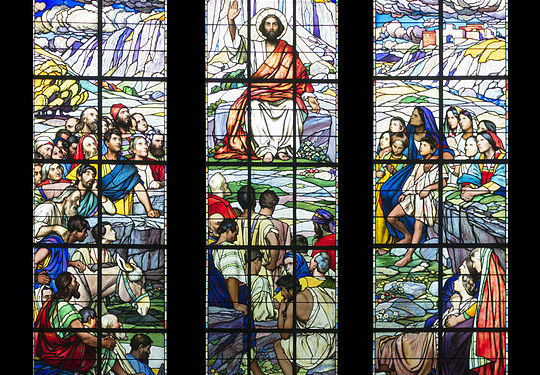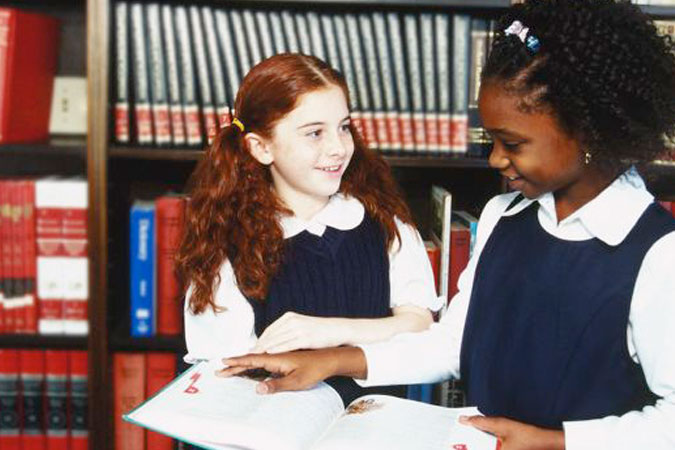
We’re a little past the halfway point of the year in my parish’s program, and in reviewing the track of lessons, I noticed that I hadn’t yet used any skits this year. Our upcoming lesson on Jesus as Teacher will change that.
Session 13 in Finding God, Grade 7, focuses on Jesus the Teacher. The chapter introduces the Sermon on the Mount, particularly the Beatitudes, and Christ’s teachings about the Kingdom of God, with a particular emphasis on his use of parables. Because these are such rich topics, I’m taking two weeks to cover these main ideas. Last week we focused on the parables, and this time we’ll look more closely at the Beatitudes. Bridging the two weeks is where the use of skits will come in handy.
I have a collection of short plays from a now out-of-print product called Scripture Comes Alive. We’ll start the session by reviewing what a parable is and naming several we explored last week. Then I’ll ask for volunteers to act in our skit and give them the appropriate script cards to help them act out two of the most famous parables, the Good Samaritan and the Prodigal Son/Forgiving Father.
Then I’ll introduce the fact that Jesus shared more of his teachings in the Sermon on the Mount. We’ll review the Beatitudes and introduce this part of the lesson with a silly skit about a bee who wants to share his attitudes—which aren’t quite what the Beatitudes teach.
The lesson will proceed from there, but I outline just this snippet to illustrate a point. It’s important to use a variety of teaching methods throughout the year. The theory of multiple intelligences tells us that, but Jesus himself exemplified that. He taught people through his actions (miracles) and his words (parables and other teachings), sometimes in large groups (Sermon on the Mount) and sometimes one-on-one (Nicodemus). He taught through example (going away to pray, embracing the sick) and through using questions (What do you want from me?). Jesus’ message was consistently about love, but it wasn’t always proclaimed in the same way. Why should our catechesis be different?
Let us embrace the use of Scripture look-ups, small group work, large group discussions, crafts, skits, music, art, guided reflections, games, media, and other techniques to meet our young people where they are and help them to walk through the door of faith.
We don’t have to be experts at all of these methods to incorporate them into the faith formation classroom, but we have to be open to trying different things. By all means, the more artistic among us should share their crafting skills with students, and the musical should share their talents. But any of us can play a song recording or lead a discussion about a work of art as suggested by a good teacher’s guide or the accompanying website for the curriculum. We must remember to engage the hearts and minds of those we catechize with a variety of tools and not get discouraged if a given technique doesn’t work one week or with a particular group. Next year’s group may like acting things out better than drawing. One week a writing activity will work better than a discussion. We serve our students best when we, like Jesus the Teacher, pay attention to the needs of those in front of us and respond accordingly.
What technique haven’t you used in your classes this year that perhaps you’d like to try?
Image by Dougjenkinson (Own work) [CC BY-SA 4.0], via Wikimedia Commons.





Hey Denise, good luck with your skits! Sounds like fun and kids are natural actors with their vivid imaginations! A couple of years ago, I taught the Sermon on the Mount and it was in the middle of the Presidential election so kids were accustomed to hearing campaign speeches being delivered at conventions. I introduced the Sermon on the Mount as Jesus’ “keynote address” which, in many ways, it was. I then had volunteers take turns delivering segments of the speech – Matthew ch 5 – and had them raise their voice and pause at the end of each point so that the crowd could respond with applause and cheers. It was a lot of fun (and a bit noisy!) but it caused them to hear the Sermon on the Mount in a fresh and different way.
Joe, I’ve considered working more with the full Sermon on the Mount, but needed a way to make it more than reading the chapters aloud. While I believe junior high students should be reading Bible passages, the Sermon on the Mount is longer than many attention spans of that age can handle. After all, it was delivered as a “keynote address,” as you suggest, not a paper to read. Maybe I’ll try your idea next time the topic arises.
Great post, Denise! This is exactly the type of lessons that students will remember!
Thanks, Barb. I hope they do remember and can take the lessons with them after the session is done.
I love what you mentioned about using the scripture look up groups and other groups to meet the youth where they are at. Its important to show genuine interest in their learning and understanding the gospel and not just their ability to listen to it. I have always been under the impression that it is impossible to force spiritual things but I think these groups will help create a spirit filled environment. Thanks for the great idea.
Johnny, thanks for reading. You’re right that being genuinely interested in the kids’ learning is key.